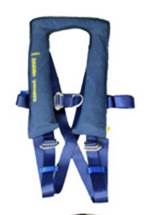The work performed aboard commercial vessels at sea brings inherent risk and Australia has seen a number of fatalities as a result of man overboard (MOB) incidents. Rural Industries Research and Development Corporation reported that between 1989 and 1992, 55 deaths resulted from man overboard events.
Personal flotation devices (PFD) can save lives in high risk conditions and some newer designs may even be suitable to wear at all times.
A study of coronial inquests and other research shows that PFDs can save lives if worn on deck during high-risk conditions where MOB incidents are more likely to occur.
Your duties as an employer
PCBUs have a legal responsibility to ensure the health and safety of their workers, by eliminating or minimising risks that may cause them harm, so far as is reasonably practicable. You also owe the same duty of care to independent contractors and others who may be at risk from the work you carry out.
A vessel owner is a PCBU. As an owner, you have a duty to ensure that the vessel is mechanically sound and in a safe and stable condition. This includes providing and maintaining safety equipment on-board, such as marine radios, flares, Emergency Position Indicating Radio Beacons (EPIRBs) and PFDs.
As a Master, you have a duty to not put yourself or your crew at risk by your actions (or lack of action), so far as is reasonably practicable. Your duty includes maintaining a safe work environment and safe systems of work.
Where the owner and master are different PCBUs, there is also the duty to consult, cooperate and coordinate with each other to prevent risks to health and safety of workers. Further guidance is available from the Australian Maritime Safety Authority's General Safety Duties.
The types of MOB incidents on commercial fishing vessels that have led to deaths of crew include:
- falls nobody sees, for example when working alone, on watch, or urinating over the side
- falls when working or being on deck, which crew see as they happen.
Cold water can be a factor in these deaths. The potential for both types of falls to occur, and a quick response to them, must be addressed as part of the risk assessment and management for a vessel’s emergency planning.
Situations that increase the risk of a MOB incident
- Severe sea and/or wind conditions, which may impact vessel stability or a person’s balance.
- Night time or dark conditions, which increase the risk of an unseen MOB incident – particularly when people are close to the side or stern of the vessel without communicating with the crew (e.g. urinating or smoking away from other people).
- The methods used when retrieving pots and equipment, (eg. the degree to which crew may be required to lean over the side of the vessel, or the risk of joined working strings of pots pulling people over the side).
- Slip or trip hazards on deck (eg. uncoiled ropes).
- Inexperience or poor judgement due to lack of knowledge.
- Impaired judgement and reaction time due to fatigue, or drug or alcohol use.
For further guidance on risk factors, refer to the Code of Practice - Man overboard: Prevention and response, 2010, Government of Western Australia.
Practical solutions
- Always check and monitor the weather forecast and ensure people on the vessel understand the risks of different weather and water conditions.
- Maintain visual contact or verbal communication between master and crew when on deck, especially at night.
- Provide suitable training for all people on the vessel, on fishing tasks, equipment retrieval, keeping a safe workplace and the importance of communicating with others.
- Ensure there are no slip or trip hazards that could cause a person to fall overboard.
- Prevent people from working if they show signs of impaired reactions/judgement which place them at greater risk.
- Provide training and run regular drills on emergency, rescue and evacuation procedures, and the effects of cold water immersion.
- Ensure everyone can use a PFD and understand when they are required to wear them.
- Select PFDs that are fit for purpose, fit each worker properly, and designed to keep a person’s head above water. Follow the manufacturer’s instructions for PFD maintenance.
Selecting the appropriate PFD
There are specific requirements with respect to carrying lifejackets under the National Standard for Commercial Vessels Section C7A. There are inflatable PFDs available that meet these requirements, some of which may be suitable to wear at all times whilst on the vessel and some that also automatically inflate if a person falls into the water.

When selecting a PFD, SafeWork SA recommends that PCBUs consider the type of conditions the vessel is operating in; ensuring the PFD provides support to the head and body and is fitted correctly to the individual. PFDs should be worn during periods of MOB risk. Owner and master need to consult with crewmembers to effectively identify tasks and conditions that may lead to MOB events.
Further information
AS 4758.1:2005 Lifejacket, Part 1: General Requirements (available for viewing at the SafeWork SA library)
How to manage work health and safety risks - Code of Practice
Managing the risk of falls in the workplace - Code of Practice


